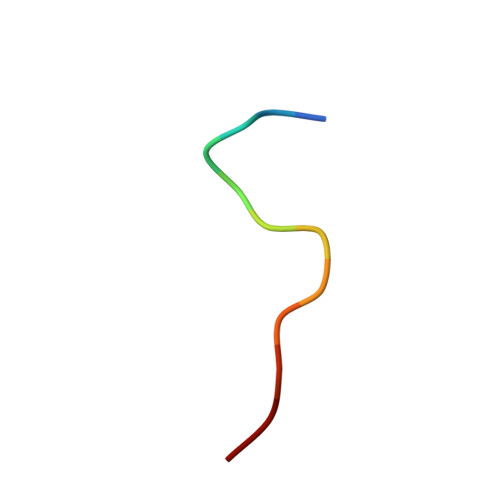Targeting cancer addiction for SALL4 by shifting its transcriptome with a pharmacologic peptide.
Liu, B.H., Jobichen, C., Chia, C.S.B., Chan, T.H.M., Tang, J.P., Chung, T.X.Y., Li, J., Poulsen, A., Hung, A.W., Koh-Stenta, X., Tan, Y.S., Verma, C.S., Tan, H.K., Wu, C.S., Li, F., Hill, J., Joy, J., Yang, H., Chai, L., Sivaraman, J., Tenen, D.G.(2018) Proc Natl Acad Sci U S A 115: E7119-E7128
- PubMed: 29976840
- DOI: https://doi.org/10.1073/pnas.1801253115
- Primary Citation of Related Structures:
5XWR - PubMed Abstract:
Sal-like 4 (SALL4) is a nuclear factor central to the maintenance of stem cell pluripotency and is a key component in hepatocellular carcinoma, a malignancy with no effective treatment. In cancer cells, SALL4 associates with nucleosome remodeling deacetylase (NuRD) to silence tumor-suppressor genes, such as PTEN. Here, we determined the crystal structure of an amino-terminal peptide of SALL4(1-12) complexed to RBBp4, the chaperone subunit of NuRD, at 2.7 Å, and subsequent design of a potent therapeutic SALL4 peptide (FFW) capable of antagonizing the SALL4-NURD interaction using systematic truncation and amino acid substitution studies. FFW peptide disruption of the SALL4-NuRD complex resulted in unidirectional up-regulation of transcripts, turning SALL4 from a dual transcription repressor-activator mode to singular transcription activator mode. We demonstrate that FFW has a target affinity of 23 nM, and displays significant antitumor effects, inhibiting tumor growth by 85% in xenograft mouse models. Using transcriptome and survival analysis, we discovered that the peptide inhibits the transcription-repressor function of SALL4 and causes massive up-regulation of transcripts that are beneficial to patient survival. This study supports the SALL4-NuRD complex as a drug target and FFW as a viable drug candidate, showcasing an effective strategy to accurately target oncogenes previously considered undruggable.
Organizational Affiliation:
Cancer Science Institute of Singapore, National University of Singapore, 117599 Singapore.















